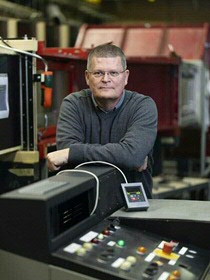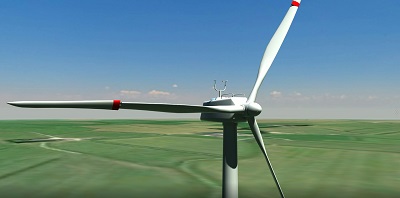European Patent further accelerates wind energy research at the UG | Eize Stamhuis

Prof. Eize Stamhuis from the University of Groningen has received a European patent for a biomimetic wind turbine design based on the wings of albatrosses. Biomimetics means that you use nature as an example for technological applications. The wind turbine design is a result of the research in the biomimetics group of Prof. Stamhuis, within the Energy and Sustainability Research Institute Groningen (ESRIG). For a number of years, his group has been conducting research into improving the yield of wind turbines, particularly at low wind speeds. Wind farms now often do not achieve maximum production because the wind turbines often run with a low efficiency at low wind speeds.
Wind turbines can get almost the maximum attainable energy when there is a strong wind. If there is little wind, many turbines will stop or run with little yield. These low wind speed periods are common in the Netherlands: a windmill operates under its best abilities for seventy to eighty percent of the time.

Oscillating wings
Sea birds such as albatrosses and petrels can handle low wind speeds very well. Smaller birds will beat their wings faster or in a different way to generate sufficient upward force, but the wings of, for example, albatrosses are too long to do that. Instead, they let their wings wiggle around the longitudinal axis, which is called oscillating. Due to these oscillations, the air flow over the wing almost separates from the wing surface but in the same time yielding higher upwards forces. Before the air flow completely separates, the wing 'wiggles' back. In this way the peak forces are up to twice as high and the average lift forces as high as 125 to 150 percent of the normal force.
Prof. Stamhuis tested this principle of oscillating wings in a flow tank and subsequently applied it to wind turbines. In tests with a relatively small wind turbine in the ESRIG wind tunnel, it was found that at low wind speeds even more than 200 percent of the normal energy was generated when the 'Albatrozz principle' was applied.
Patent
The discovery was first registered in a national patent, but is now also registered in a European patent. In addition, patenting in China is pending. The principle of 'lift-enhancing periodic stall' has not previously been applied to wind turbines and there is a lot of interest from the wind industry. That is why a consortium has been formed consisting of the University of Groningen and the companies EmpowerMi (Groningen) and RG-Projects (Leiden). This consortium must make the invention available under license for use on large wind turbines.

Big scale
In order to demonstrate the functionality on a large scale, the researchers hope to test it on two turbines with a rotor diameter of 52 meters and a maximum available power of 850 kW, within shortly. There are also concrete plans to set up a spin-off BV that will take care of the marketing of licenses for both new turbines and the improvement of existing turbines (retrofits). The researchers have already received an NWO Take-off grant to explore and deploy commercialization.
More news
-
15 September 2025
Successful visit to the UG by Rector of Institut Teknologi Bandung
